Human islet amyloid polypeptide at the air-aqueous interface: a Langmuir monolayer approach
- PMID: 22787008
- PMCID: PMC3479924
- DOI: 10.1098/rsif.2012.0368
Human islet amyloid polypeptide at the air-aqueous interface: a Langmuir monolayer approach
Abstract
Human islet amyloid polypeptide (hIAPP) is the source of the major component of the amyloid deposits found in the islets of Langerhans of around 95 per cent type 2 diabetic patients. The formation of aggregates and mature fibrils is thought to be responsible for the dysfunction and death of the insulin-producing pancreatic β-cells. Investigation on the conformation, orientation and self-assembly of the hIAPP at time zero could be beneficial for our understanding of its stability and aggregation process. To obtain these insights, the hIAPP at time zero was studied at the air-aqueous interface using the Langmuir monolayer technique. The properties of the hIAPP Langmuir monolayer at the air-aqueous interface on a NaCl subphase with pH 2.0, 5.6 and 9.0 were examined by surface pressure- and potential-area isotherms, UV-Vis absorption, fluorescence spectroscopy and Brewster angle microscopy. The conformational and orientational changes of the hIAPP Langmuir monolayer under different surface pressures were characterized by p-polarized infrared-reflection absorption spectroscopy, and the results did not show any prominent changes of conformation or orientation. The predominant secondary structure of the hIAPP at the air-aqueous interface was α-helix conformation, with a parallel orientation to the interface during compression. These results showed that the hIAPP Langmuir monolayer at the air-aqueous interface was stable, and no aggregate or domain of the hIAPP at the air-aqueous interface was observed during the time of experiments.
Figures








Similar articles
-
Molecular Structure, Membrane Interactions, and Toxicity of the Islet Amyloid Polypeptide in Type 2 Diabetes Mellitus.J Diabetes Res. 2016;2016:5639875. doi: 10.1155/2016/5639875. Epub 2015 Nov 9. J Diabetes Res. 2016. PMID: 26636105 Free PMC article. Review.
-
Human islet amyloid polypeptide (hIAPP) - a curse in type II diabetes mellitus: insights from structure and toxicity studies.Biol Chem. 2020 Sep 4;402(2):133-153. doi: 10.1515/hsz-2020-0174. Print 2021 Jan 27. Biol Chem. 2020. PMID: 33544470 Review.
-
Study of the aggregation of human insulin Langmuir monolayer.Langmuir. 2012 Feb 21;28(7):3369-77. doi: 10.1021/la204201w. Epub 2012 Feb 6. Langmuir. 2012. PMID: 22263642
-
Intra- and extracellular amyloid fibrils are formed in cultured pancreatic islets of transgenic mice expressing human islet amyloid polypeptide.Proc Natl Acad Sci U S A. 1994 Aug 30;91(18):8467-71. doi: 10.1073/pnas.91.18.8467. Proc Natl Acad Sci U S A. 1994. PMID: 8078905 Free PMC article.
-
Comparative molecular dynamics study of human islet amyloid polypeptide (IAPP) and rat IAPP oligomers.Biochemistry. 2013 Feb 12;52(6):1089-100. doi: 10.1021/bi301525e. Epub 2013 Jan 29. Biochemistry. 2013. PMID: 23331123
Cited by
-
Heterotropic Modulation of Amylin Fibrillation by Small Molecules: Implications for Formulative Designs.Protein J. 2020 Feb;39(1):10-20. doi: 10.1007/s10930-019-09877-w. Protein J. 2020. PMID: 31808036
-
A Sigma1 Receptor Agonist Alters Fluidity and Stability of Lipid Monolayers.Langmuir. 2024 Mar 26;40(12):6484-6492. doi: 10.1021/acs.langmuir.4c00053. Epub 2024 Mar 12. Langmuir. 2024. PMID: 38470245 Free PMC article.
-
New Insights from Sum Frequency Generation Vibrational Spectroscopy into the Interactions of Islet Amyloid Polypeptides with Lipid Membranes.J Diabetes Res. 2016;2016:7293063. doi: 10.1155/2016/7293063. Epub 2015 Nov 30. J Diabetes Res. 2016. PMID: 26697504 Free PMC article. Review.
-
The kinetics of islet amyloid polypeptide phase-separated system and hydrogel formation are critically influenced by macromolecular crowding.Biochem J. 2021 Aug 13;478(15):3025-3046. doi: 10.1042/BCJ20210384. Biochem J. 2021. PMID: 34313292 Free PMC article.
-
In silico studies of the human IAPP in the presence of osmolytes.J Mol Model. 2022 Jun 14;28(7):188. doi: 10.1007/s00894-022-05180-1. J Mol Model. 2022. PMID: 35697975
References
-
- Shaw J. E., Sicree R. A., Zimmet P. Z. 2010. Global estimates of the prevalence of diabetes for 2010 and 2030. Diabetes Res. Clin. Pract. 87, 4–1410.1016/j.diabres.2009.10.007 (doi:10.1016/j.diabres.2009.10.007) - DOI - DOI - PubMed
-
- Song S. H. 2008. Review. Early-onset type 2 diabetes mellitus: a condition with elevated cardiovascular risk? Br. J. Diabetes Vasc. Dis. 8, 61–6510.1177/14746514080080020201 (doi:10.1177/14746514080080020201) - DOI - DOI
-
- Alberti G., Zimmet P., Shaw J., Bloomgarden Z., Kaufman F., Silink M. 2004. Type 2 diabetes in the young: the evolving epidemic. Diabetes Care 27, 1798–181110.2337/diacare.27.7.1798 (doi:10.2337/diacare.27.7.1798) - DOI - DOI - PubMed
-
- Gedulin B., Cooper G. J. S., Young A. A. 1991. Amylin secretion from the perfused pancreas: Dissociation from insulin and abnormal elevation in insulin-resistant diabetic rats. Biochem. Biophys. Res. Commun. 180, 782–78910.1016/S0006-291X(05)81133-7 (doi:10.1016/S0006-291X(05)81133-7) - DOI - DOI - PubMed
-
- Westermark P., Li Z.-C., Westermark G. T., Leckström A., Steiner D. F. 1996. Effects of beta cell granule components on human islet amyloid polypeptide fibril formation. FEBS Lett. 379, 203–20610.1016/0014-5793(95)01512-4 (doi:10.1016/0014-5793(95)01512-4) - DOI - DOI - PubMed
Publication types
MeSH terms
Substances
LinkOut - more resources
Full Text Sources
Medical

